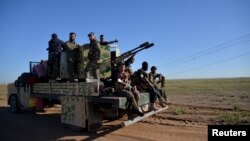Here's a brief snapshot of the headlines this week from Iraq, Syria, and other locations impacted by Islamic State:
-- The battle for Mosul, in northern Iraq, continues to heat up but is far from over. The city is very important for many reasons. Before Islamic State took over in June 2014, it was Iraq's third largest city, and while it was a diverse city, it is also located at the western edge of what is commonly known as Iraqi-Kurdistan. Mosul is on an important crossroad as it is located on the Tigris River and is not far from Irbil, Iraq's fourth largest city.
-- The U.S. military has been arming and training the Kurdish Peshmerga who are preparing to assault the city.
-- Islamic State (IS) terrorists destroyed a 2,000 year-old architectural landmark, the Mishqi Gate, in the city of Nineveh, just north of Mosul.
-- French Defense Minister Jean-Yves Le Drian gave a speech in Baghdad this week where he said that Islamic State's strongholds in Mosul, Iraq, and Raqqa, Syria, must fall this year. There are indications that Mosul could fall, but the defeat of the Islamic State in its capital in Syria is still a long way off.
-- Brookings Institute's Kenneth Pollack wrote that Islamic State is "taking a beating" near Mosul and Fallujah thanks to U.S. airstrikes, made possible by a change in strategy by the U.S.-Iraqi coalition, but warns that "Baghdad's announcement that the liberation of Mosul has begun is a bit premature."
-- The Institute for the Study of War (ISW) has warned that the Iraqi government is showing signs of collapse as political infighting has seriously damaged Iraqi Prime Minister Haidar Al-Abadi's ability to govern. Iraq's political developments could have a significant impact on the country's battlefields, which is one reason why the United States is looking to other sources, like the Kurds in both Iraq and Syria, to lead the charge against Islamic State.
-- In ISW's "Iraq Situation Report" from April 5 to April 11, they reported that Washington is considering building additional firebases to break IS lines near Nineveh since momentum in the area has stalled:
"The proposal would provide necessary assistance for the ground offensive while demonstrating U.S. support for the Iraqi Security Forces and the Iraqi government, though these additions may not be significant enough factors to make up for the limited number of ISF [Iraqi Security Forces] members currently engaged in operations."
-- In Syria on April 11, IS forces recaptured the northern town of Al-Rai, close to the border with Turkey, captured from IS by rebel groups under the Free Syrian Army (FSA) banner on April 7. The BBC reports that IS was able to push west of Al-Rai and capture six other villages, halting the momentum of FSA rebels who were pushing east toward IS strongholds. Prior to the reversal, FSA rebels had reportedly pushed within 10 kilometers of the key northern town of Dabiq.
-- The Daily Beast has written a profile of the misunderstood Abd Al-Rahman Mustafa Al-Shakhilar Al-Qaduli, a man commonly known as Haji Imam, reportedly from Islamic State and described as "the No. 2 man in the world’s most dangerous terror organization."
Michael Weiss and Hassan Hassan write that "he was one man, not two. He had at least seven names, and was mistakenly pronounced dead four times. But the fog surrounding [IS's] No. 2 is finally beginning to part."
The report warns that the death of high-ranking IS officials is important but, if the two-decade campaign against Al-Qaeda is any indication, this may not even be the beginning of the end:
"For a decade, since the killing of its top leaders in 2006 (Al-Zarqawi) and 2010 (Abu Omar al-Baghdadi and his war minister Abu Ayyub al-Masri), [IS] has adapted to changing wartime exigencies (the al-Anbar Awakening, the "surge," the U.S. military withdrawal, the Syrian revolution) and regrouped. It went from being a foreigner-led insurgency to a cosmetically "Iraqized" one to a genuinely Iraqi-led caliphate enterprise. With its renewed emphasis on attacking Western targets inside the West, [IS] has similarly undergone a quiet transformation under the past two years, which is really more of a bifurcation into two organizations."





